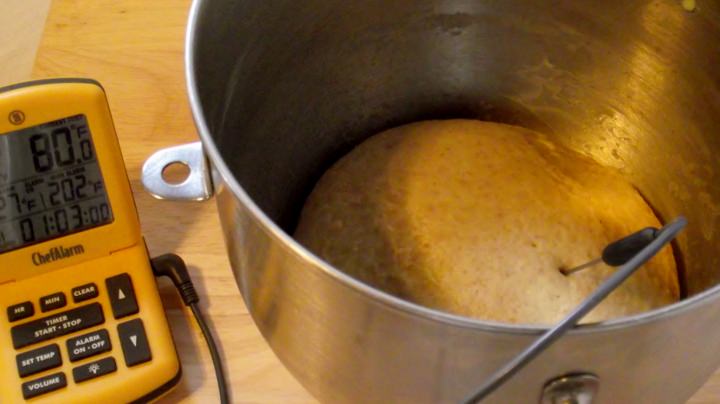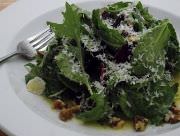Dough Temperature
Learn to bake bread like a professional baker. Always calculate your desired dough temperature. It doesn't matter what kind of flour you are using, bread flour, whole grain wheat, or all-purpose your results will be consistent and you will have more control over the dough.
The final temperature of your dough is affected by the temperature of the ingredients, the ambient temperature, and the friction created during kneading or working the dough.

Calculate Desired Dough Temperature
Desired dough temperature, or DDT, is important because it directly affects fermentation. The colder the final temperature of a dough, the longer the fermentation. Conversely, the warmer the final temperature, the shorter the fermentation.
Bakers have found that dough develops best around 75° F. Bakers have, also, found that the only really effective control they have over temperature is through water.
To figure out the correct water temperature to produce a final dough temp of 75° F, multiply 75° by the number of temperature factors, in this case there are 3. The room temperature, flour temperature, and friction. Most of the time your flour temperature will be the same as your room temperature, unless you store your flour in the freezer or refrigerator. 75° times 3 is 225, this is known as the total temperature factor, and abbreviated as TTF. The friction temperature from kneading the dough is going to be between 5 and 10 degrees F. The friction temperature from using a mixer is going to be the number of minutes mixing times 2. So if you mix for 7 minutes the mixer friction is going to be 7 times 2 or 14°.
To calculate the temperature increase from kneading, take the temperature of your dough when it just comes together, and then again when you are done kneading it. The difference is how much the dough heated up.
A quick example. Your DDT is 78 degrees. Your room temperature is 75 degrees, your flour temperature is 70 degrees. You have found that your kneading heats the dough by 8 degrees. So, 78 times 3 is 234. 234 minus the room temperature, 75, minus the flour temperature, 70, minus the friction temperature, 8.
So, you subtract 234-75-70-8, which is 81. You should use 81-degree water to get the correct temperature. Conversely, you can add 75, 70, and 8 to get 153. Then subtract 153 from 234 to arrive at 81. You will experience some variation in the final temperature. However, a final temperature between 70° and 80° F is perfectly acceptable.
What about every country, except this one, that uses Celsius? Your ideal temperature should be about 25° C. 25 times 3 is 75°. 75 minus the room temperature, 24°, minus the flour temperature, 21°, minus the friction temperature, 4.4°. So your water temperature needs to be about 25.6° C.
Note that for room temperature and flour temperature, I did a straight conversion from Fahrenheit to Celsius. Mixer friction, however, is a temperature difference, thus conversion to the equivalent amount in Celsius is not the same.
To convert from F to C you subtract 32 and multiply by 5, then divide by 9. For a temperature difference conversion, you leave out the subtraction of 32. Thus a mixer friction factor of 8° F is equivalent to 4.4° C, not to -13° C.
Tags: dough temperature, learn to bake, whole grain wheat




